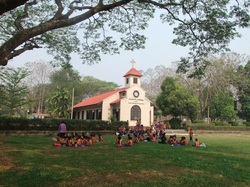 Cultural engagement is a fairly recent development in the course of religious understanding. D.T. Niles was the first prominent modern Christian theologian to complain about how Christianity tries to overwhelm rather than engage other cultures. His comments were directed at the Protestants in Southern Asia. Niles had a lot to do with the formation of the East Asian Christian Conference (now called the Christian Conference of Asia) which famously encouraged adaptation of cultural arts and traditions. Protestants weren’t alone in this, nor first. Mother Theresa of Calcutta famously adopted the Indian sari as the costume for the Sisters of Charity following the lead of 17th century Jesuits in China who portrayed themselves as comparable to Confucian scholars. However, the “great missionary movement” of 1800 to 1920 which turned into the ecumenical movement of 1920 to 2000 (using purely arbitrary terms and dates) was more concerned about the promotion of a Christian counter-culture. H. Richard Niebuhr analyzed this critically in his highly regarded 1951 book Christ and Culture. Here in Thailand any attempts at cultural engagement or even efforts to adopt cultural forms were sporadic and controversial. The hymnal of the mainline Protestant Church of Christ in Thailand contains less than half a dozen hymns or canticles that are authentic traditional Thai melodies and even fewer that are original compositions in Thai style. The use of Thai classical and folk instruments was vigorously opposed in the church when first introduced and still has not replaced western instruments on a regular basis in any church I know of. Very few architectural attempts have been made by Catholics or Protestants to emulate or adopt Thai religious structural forms. When Ruamrudee Catholic Church was built in 1954 in the style of a Thai Buddhist vihara or assembly hall (see: www.holyredeemerbangkok.net then click on English and then on “history” to see a picture of this outstanding building), it was conservative Buddhists who protested this as an attack on Buddhism. Their criticism when it flared up back 40 years ago is reminiscent of the Muslim protest last year against Christians using the term Allah for God in the new editions of the Malay Bible. Meanwhile, the Church is constantly contending with those who persist in portraying Christianity as a cultural invasion. When squalls break out they sound not unlike the Christian defenders in America who rail against the rise of Islamic groups. Multi-culturalism is a hard product to sell. Christianity is still widely (almost universally in Thailand) regarded as a foreign faith. This is constantly being reinforced by such evidence as the use of European music in Christian worship and non-Asian portrayals of Jesus in movies like this year’s Son of God. Sallman’s “Head of Christ” is found in a vast majority of Christian homes in Thailand. By contrast, Buddha is Asian, not exclusively Thai, but certainly closer to home than Jesus. Wouldn’t it have been better for the church to narrow the cultural gap? It has been more convenient for the churches here in Thailand to refrain from cultural engagement. There was, however, another option that was also largely rejected. That was a form of cultural innovation. In the face of daunting opposition to the adaptation of classical cultural forms, all of them being royal or religious, in an attempt to carve a culturally unique niche for the Church, some architects tried to design churches that are distinctly Thai and Christian. Function took precedence over symbolic tradition. Taylor Potter’s design for First Thai Church in Chiang Mai and Amos Ih-Tiao Chang’s design for the chapel at Bangkok Christian College, are highly recognizable as one-of-a-kind structures. The more recent and spectacular Roman Catholic cathedral in Udorn and the chapel at Saeng Tham Theological Seminary in Nakhon Pathom are edifices that largely spurn old traditions. Ed Sue’s design for the Henry Luce Chapel of Payap University is innovative rather than classic, as well. Left to their own devices, however, Thai congregations show a remarkable consistency in preferring rectangular buildings with a steeple with a cross on top. Scores of very similar churches have been built in the last 25 years and several are being constructed right now. What is the real motive for sticking to the Protestant classic, like the church in Prae pictured above? In the context of the villages and small towns of Thailand, those churches make a statement. They say, “We are Christian.” That is more important than saying, “We are Thai.” Beyond that simple affirmation, which is as far as most people care to go, the display of Christian art and forms is to identify with the worldwide Church. Pews, hymns, pulpits, crosses in front, bells if they are available – those are ways of joining the Christian tribe. There is no compelling reason to stress a national cultural distinction, or to try to deny that the roots of Christian culture are Western. Even if a demographic shift occurs, moving the center of Christian population south and east, being part of the large Christian culture will be of greater importance than being uniquely Thai.
0 Comments
Leave a Reply. |
AuthorRev. Dr. Kenneth Dobson posts his weekly reflections on this blog. Archives
March 2024
Categories |
| Ken Dobson's Queer Ruminations from Thailand |
|
 RSS Feed
RSS Feed
